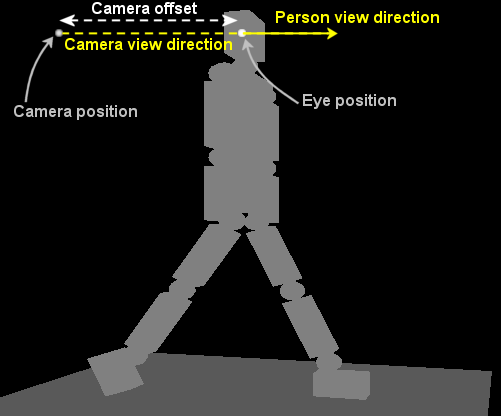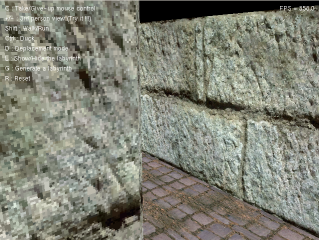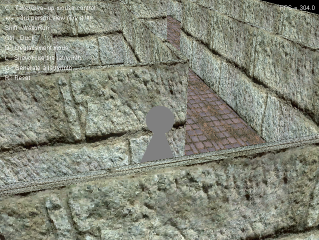![]()
![]()
Time based movement is essential for a fluid and a constant movement.
Moreover, it is very simple to add it to our camera.
Instead of increasing movement just when a key is pressed, we keep the deplacement in a variable
:
|
Variables |
|
/** Next position/orientation - For time based movement */ |
At each frame, we will move the camera depending on its speed, the rendering/frame time and the
above deplacement
variables.
For this, we need to call a method at each frame : update.
|
Update (1) |
|
public synchronized void update() |
Now, we know the time and the wanted deplacement.
You've have to specify the camera speed and you can calculate the deplacement for the current frame
:
currentDeplacement = speed * time

Time based movement
This allow to move to a constant speed.
|
Update (2) |
|
//Maximum deplacement = speed *
time |
Third person view is very easy to implement.
In case of a camera attached to a person, "classic" view is when the camera is positionned at the
person's eye location and look at the same direction.
For a third person view, the camera is positionned at a different location than the
person's eye, generally behind.
There are basically two differents third person view :
- the camera is attached somewhere behind the person. The camera follow the person (ie move
when person move).
- the camera is fix and look toward the person location.
I've choose to use the first kind.
This picture represents what is a third person view :

Third person view description
Now, how to do this ?
First, we need to store cameraOffset to know where the camera should be
positionned :
|
Variable |
|
/** Camera offset (3rd person view) */ |
You can notive that I also use newCameraOffset to use time based movement.
The only thing changed for take third person view in account is the camera
location when calling lookAt.
Camera position is the eye position to which it is subtract the forward vector
multiplied by cameraOffset
ie cameraPosition = eyePosition - cameraOffset * forward
|
New LookAt |
|
public void lookAt(GLDrawable glDrawable) |
Here is the difference between a normal view and a third person view :


Normal vs Third person view
This mode is associated with a terrain.
At the camera location, the camera check the terrain height. If the camera is
above the terrain, it should be falling due to gravity (free fall). Fall stop
when camera location is equal to terrain height (can't goes throw terrain).
Gravity also take place when jumping.
A solid is submit to the gravity force due to his mass m. The fondamentale
principle of the dynamic says : sum of the forces applied to a solid equals
to the solid mass multiply to its acceleration.
The only force for a free fall is the gravity force (m*g), so we have : m*g = m*acceleration
ie acceleration = g
By integrating two times, position = g*t²/2 + v0*t
//v0 : initial speed along vertical
direction
Jumping is a free fall. An initial (positive) speed along the vertical direction
is applied to an object. This speed will decrease due to the gravity force, and
will becomes negative.
To implement duck action, I use a factor (heightFactor) applied to the viewer height. Its value goes from 1 (normal state) to 0.5 for a half duck (half percent of the viewer height).
|
getCameraPosition change |
|
public Vector3f getCameraPosition() |
Value of this factor is change into update method to apply a constant deplacement from normal and duck state :
|
getCameraPosition change |
|
if(duck) |
![]()
Return to Tutorial 26
![]()
| Last modified on 06/01/2007 | |
| Copyright © 2004-2012 Jérôme JOUVIE - All rights reserved. | http://jerome.jouvie.free.fr/ |